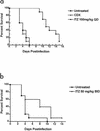Efficacy of amphotericin B or itraconazole in a murine model of central nervous system Aspergillus infection
- PMID: 12543700
- PMCID: PMC151760
- DOI: 10.1128/AAC.47.2.813-815.2003
Efficacy of amphotericin B or itraconazole in a murine model of central nervous system Aspergillus infection
Abstract
Given the greater than 90% lethality of clinical central nervous system (CNS) aspergillosis despite current therapies, there is a need for an animal model to study therapeutic strategies. We previously established a model of CNS aspergillosis by intracerebral infection and report here the results of treatment with the two therapies with the greatest clinical experience, i.e., treatments with amphotericin B (AMB) and itraconazole (ITZ). Mice were given cyclophosphamide to produce pancytopenia. AMB was given intraperitoneally (i.p.; 3 mg/kg of body weight) or intravenously (i.v.; 0.8 mg/kg) once daily. ITZ in cyclodextrin was given by gavage once daily at a dose of 100 mg/kg or twice daily at 50 mg/kg. Treatments were started at day 1 postinfection and given for 10 days. At day 15, survivors were euthanatized. Ninety percent of the mice given no treatment died by day 6, and 100% died by day 10. Mice treated with AMB either i.p. or i.v. had 40% survival. Mice treated with ITZ either once or twice per day had a median survival time of 10 days, compared with 4 days for control animals, but a survival rate of only 10%. AMB and ITZ prolonged survival (P, <0.0001 to <0.05) compared with controls. Brains from surviving mice had CFU of Aspergillus fumigatus. This model can be used to compare newer antifungals and to study combination therapy or immunotherapy to find better therapeutic alternatives.
Figures


References
-
- Chiller, T. M., J. Capilla Luque, R. A. Sobel, K. Farrokhshad, K. V. Clemons, and D. A. Stevens. 2002. Development of a murine model of cerebral aspergillosis. J. Infect. Dis. 186:574-577. - PubMed
-
- Denning, D. W., and D. A. Stevens. 1990. Antifungal and surgical treatment of invasive aspergillosis: review of 2,121 published cases. Rev. Infect. Dis. 12:1147-1201. - PubMed
-
- Perfect, J. R., G. M. Cox, J. Y. Lee, C. A. Kauffman, L. de Repintigny, S. W. Chapman, V. A. Morrison, P. Pappas, J. W. Hiemenz, D. A. Stevens, and the Mycoses Study Group. 2001. The impact of culture isolation of Aspergillus species: a hospital-based survey of aspergillosis. Clin. Infect. Dis. 33:1824-1833. - PubMed
-
- Stevens, D. A., and B. H. Aristizabal. 1997. In vitro antifungal activity of novel azole derivatives with a morpholine ring, UR-9746 and UR-9751, and comparison with fluconazole. Diagn. Microbiol. Infect. Dis. 29:103-106. - PubMed
Publication types
MeSH terms
Substances
LinkOut - more resources
Full Text Sources
Medical

